
Introduction
Congratulations on your purchase and welcome to Philips! To fully benet from the
support that Philips offers, register your product at www.philips.com/welcome.
General description (Fig. 1)
A Lid
B Spout
C Scale lter
D Water level indicator
E Temperature settings
F Temperature knob
G Base
H Mains cord
I Cord storage facility
J On/off switch with power-on light
K Lid release button
Important
Read this user manual carefully before you use the appliance and save it for future
reference.
Danger
- Do not immerse the appliance or the base in water or any other liquid.
Warning
- Check if the voltage indicated on the appliance corresponds to the local mains
voltage before you connect the appliance.
- Do not use the appliance if the plug, the mains cord, the base or the appliance
itself is damaged.
- If the mains cord is damaged, you must have it replaced by Philips, a service
centre authorised by Philips or similarly qualied persons in order to avoid a
hazard.
- This appliance is not intended for use by persons (including children) with
reduced physical, sensory or mental capabilities, or lack of experience and
knowledge, unless they have been given supervision or instruction concerning
use of the appliance by a person responsible for their safety.
- Children should be supervised to ensure that they do not play with the
appliance.
- Keep the mains cord out of the reach of children. Do not let the mains cord
hang over the edge of the table or worktop on which the appliance stands.
Excess cord can be stored in or around the base of the appliance.
- Hot water can cause serious burns. Be careful when the kettle contains hot
water.
- Do not touch the body of the kettle during and some time after use, as it gets
very hot. Always lift the kettle by its handle.
- Never ll the kettle beyond the maximum level indication. If the kettle has
been overlled, boiling water may be ejected from the spout and cause scalding.
- Do not open the lid while the water is heating up. Be careful when you open the
lid immediately after the water has boiled: the steam that comes out of the kettle
is very hot.
- This rapid-boil kettle can draw up to 13 amps from the power supply in your
home. Make sure that the electrical system in your home and the circuit to which
the kettle is connected can cope with this level of power consumption. Do not
let too many other appliances draw power from the same circuit while the kettle
is being used.
- Only use the kettle in combination with its original base.
Caution
- Do not connect the appliance to an external switching device such as a timer
and do not connect it to a circuit that is regularly switched on and off by the
utility. This prevents a hazard that could be caused by inadvertent resetting of the
thermal cut-out.
- Only connect the appliance to an earthed wall socket.
- Always place the base and the kettle on a dry, at and stable surface.
- Never ll the kettle below the 1-cup level to prevent it from boiling dry.
- The kettle is only intended for heating or boiling water. Do not use it to heat up
soup or other liquids or jarred, bottled or tinned food.
- Depending on the hardness of the water in your area, small spots may appear
on the heating element of your kettle when you use it. This phenomenon is
the result of scale build-up on the heating element and on the inside of the
kettle over time. The harder the water, the faster scale builds up. Scale can occur
in different colours. Although scale is harmless, too much scale can inuence
the performance of your kettle. Descale your kettle regularly by following the
instructions given in chapter ‘Descaling’.
- Some condensation may appear on the base of the kettle. This is perfectly
normal and does not mean that the kettle has any defects.
- Do not let any water run into the temperature knob.
- This appliance is intended to be used in household and similar applications such
as:
1 staff kitchen areas in shops, ofces and other working environments;
2 farm houses;
3 by clients in hotels, motels and other residential type environments;
4 bed and breakfast type environments.
Boil-dry protection
This kettle is equipped with boil-dry protection. This device automatically switches
off the kettle if it is accidentally switched on when there is no water or not enough
water in it. The on/off switch goes to ‘off ’ position and the power-on light goes out.
Let the kettle cool down for 10 minutes. Then lift it from its base to reset the boil-dry
protection. The kettle is now ready for use again.
Electromagnetic elds (EMF)
This Philips appliance complies with all standards regarding electromagnetic elds
(EMF). If handled properly and according to the instructions in this user manual, the
appliance is safe to use based on scientic evidence available today.
Before first use
1 Placethebaseonadry,atandstablesurface.
2 Toadjustthelengthofthecord,pushpartofitintothecordslotinthe
base.(Fig.2)
3 Rinsethekettlewithwater.
4 Fillthekettlewithwateruptothe5-cuplevel.Letthewaterboilonce(see
chapter‘Usingtheappliance’).
5 Pouroutthehotwaterandrinsethekettleoncemore.
Using the appliance
1 Fillthekettlewithwater.Youcanllthekettleeitherthroughthespoutor
throughtheopenlid.(Fig.3)
To ensure that the kettle heats the water to the set temperature, ll the kettle to the
4-cup level.
2 Closethelid.
Make sure that the lid is properly closed to prevent the kettle from boiling dry.
3 Placethekettleonitsbaseandputthepluginthewallsocket.
4 Turnthetemperatureknobtosetthedesiredtemperature(Fig.4).
1 ’Green tea’ symbol: setting for heating up water to the required temperature for
white, mate or green tea.
2 ’Coffee beans’ symbol: setting for heating up water to the required temperature
for instant coffee or drip lter coffee.
3 ’Black tea’ symbol: setting for heating up water to the required temperature for
black tea, herbal tea, red bush tea, hot chocolate, (instant) soup, pasta, rice and
noodles. Only at this setting, the water is boiled.
5 Pushdowntheon/offswitchtoswitchonthekettle.
, Thepower-onlightgoesonandthekettlestartstoheatup.
, Thekettleautomaticallyswitchesoffandthepower-onlightgoesoutwhen
thewaterreachesthesettemperature.
Note: To interrupt the heating or boiling process, switch off the kettle.
Cleaning
Alwaysunplugtheappliancebeforeyoucleanit.
Neverusescouringpads,abrasivecleaningagentsoraggressiveliquidssuchas
petroloracetonetocleantheappliance.
Neverimmersethekettleoritsbaseinwater.
1 Cleantheoutsideofthekettlewithasoftclothmoistenedwithwarmwater
andsomemildcleaningagent.
2 Cleanthescalelter.
Scale is not harmful to your health but it may give your drink a powdery taste. The
scale lter prevents scale particles from ending up in your drink. Clean the scale lter
regularly.
You can clean the lter in three ways:
1 leave the lter in the kettle when you descale the whole appliance (see chapter
‘Descaling’);
2 take the lter out of the kettle and gently brush it with a soft nylon brush under
a running tap; (Fig. 5)
3 take the lter out of the kettle and clean it in the dishwasher.
3 Afteryouhavecleanedthelterunderthetaporinthedishwasher,push
thelterbackintothespoutuntilitclicksintoplace(Fig.6).
Descaling
To prolong the life of the kettle, descale it regularly.
In case of normal use (up to 5 times a day), we recommend the following descaling
frequency:
ENGLISH


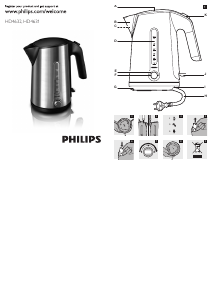

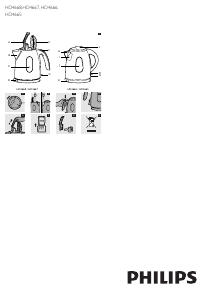
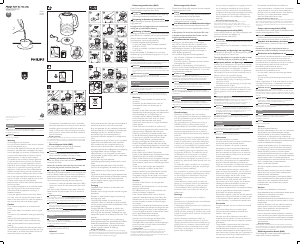
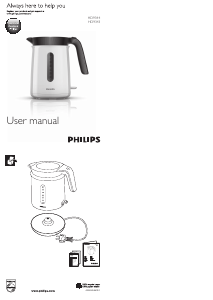
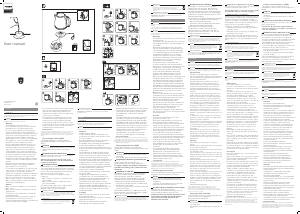
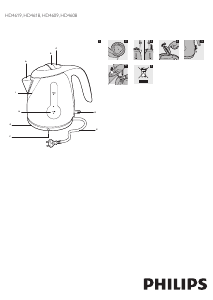
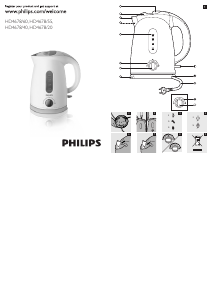
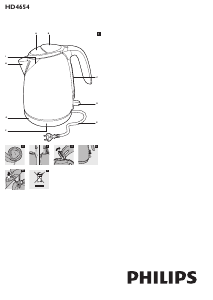
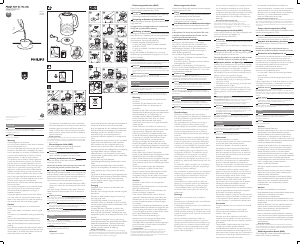
Participe da conversa sobre este produto
Aqui você pode compartilhar o que pensa sobre Philips HD4631 Jarro eléctrico. Se você tiver alguma dúvida, primeiro leia atentamente o manual. A solicitação de manual pode ser feita através do nosso formulário de contato.
responder | Isso foi útil (0) (Traduzido pelo Google)
responder | Isso foi útil (0) (Traduzido pelo Google)